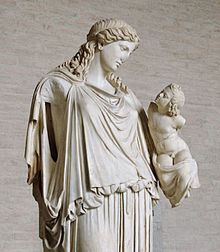| Revision as of 19:53, 6 April 2010 edit98.88.195.218 (talk)No edit summary← Previous edit | Revision as of 22:21, 26 April 2010 edit undo173.56.110.145 (talk)No edit summaryNext edit → | ||
| Line 1: | Line 1: | ||
| ]: Roman copy after ]' votive statue, c. 370BCE, in the Agora, Athens]] | ]: Roman copy after ]' votive statue, c. 370BCE, in the Agora, Athens]] | ||
| '''Eirene''', or '''Irene''' ({{lang-grc|Εἰρήνη}}, pronounced {{IPA-all|eiˈrɛːnɛː}}; Greek for "peace"; the ] equivalent was ]), one of the ], was the personification of peace, and was depicted in art as a beautiful young woman carrying a ], ] and a torch or ]. She is said sometimes to be the daughter of Zeus. | '''Eirene''', or '''Irene''' ({{lang-grc|Εἰρήνη}}, pronounced {{IPA-all|eiˈrɛːnɛː}}; Greek for "peace"; the ] equivalent was ]), one of the ], was the personification of peace, and was depicted in art as a beautiful young woman carrying a ], ] and a torch or ]. She is said sometimes to be the daughter of Zeus.She is the eldest of the Hours, and they robe and dress aphrodite. they are said to be beautiful, and dance and sing all day. They are virgins, and protect the sacred works of men. | ||
| == External links == | == External links == | ||
Revision as of 22:21, 26 April 2010

Eirene, or Irene (Template:Lang-grc, pronounced IPA: [eiˈrɛːnɛː]; Greek for "peace"; the Roman equivalent was Pax), one of the Horae, was the personification of peace, and was depicted in art as a beautiful young woman carrying a cornucopia, scepter and a torch or rhyton. She is said sometimes to be the daughter of Zeus.She is the eldest of the Hours, and they robe and dress aphrodite. they are said to be beautiful, and dance and sing all day. They are virgins, and protect the sacred works of men.
External links
This article relating to a Greek deity is a stub. You can help Misplaced Pages by expanding it. |